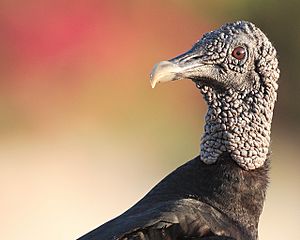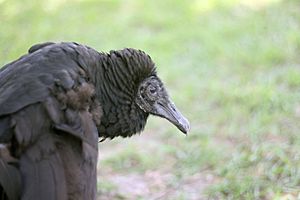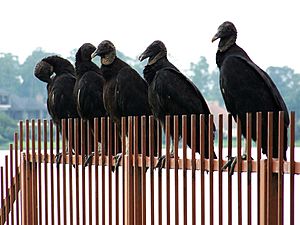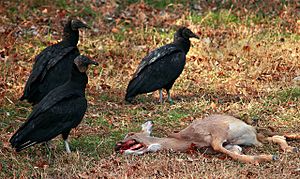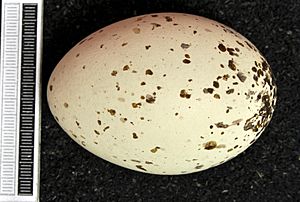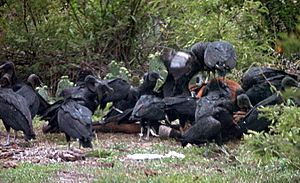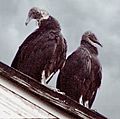Black vulture facts for kids
Quick facts for kids Black vulture |
|
|---|---|
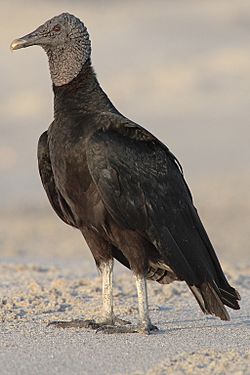 |
|
| Coragyps atratus brasiliensis in Panama | |
| Conservation status | |
| Scientific classification | |
| Kingdom: | |
| Class: | |
| Order: | |
| Family: | |
| Genus: |
Coragyps
Saint-Hilaire, 1853
|
| Binomial name | |
| Coragyps atratus |
|
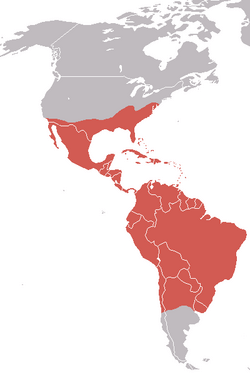 |
|
| Distribution map of the black vulture | |
The black vulture (Coragyps atratus), also known as the American black vulture, is a type of bird found in the New World vulture family.
These birds live from the southeastern United States all the way down to Central Chile and Uruguay in South America. They are a common and widespread species. However, they are not as common as the turkey vulture, which lives in even more places. Even though they have a similar name and look, the black vulture is not related to the Eurasian black vulture.
Contents
What Does a Black Vulture Look Like?
The black vulture is a fairly large bird of prey. It measures about 56 to 74 centimeters (22 to 29 inches) long. Its wingspan can be as wide as 1.33 to 1.67 meters (4.4 to 5.5 feet). Black vultures in North America and the Andes mountains can weigh from 1.6 to 3 kilograms (3.5 to 6.6 pounds). Smaller ones in tropical lowlands weigh about 1.18 to 1.94 kilograms (2.6 to 4.3 pounds).
Their feathers are mostly shiny black. Their head and neck have no feathers, and the skin is dark gray and wrinkled. Their eyes are brown. They have a single row of eyelashes on the top eyelid and two rows on the bottom. Their legs are grayish-white. The two front toes on each foot are long and have small webs at their bases. Their feet are flat and not very strong for grabbing things. Their talons are also blunt, not sharp for grasping.
The black vulture's nostrils are open, meaning you can see right through its beak from the side. Its wings are wide but somewhat short. The bottom of their main wing feathers are white. This creates a white patch on the underside of the wing that you can see when they fly. Their tail is short and square. It barely goes past the end of their folded wings. Different types of black vultures vary in size and how much white they have under their wings.
Sometimes, a black vulture can have a condition called leucism. This means it has white feathers instead of black. One such bird was seen in Piñas, Ecuador in 2005. It was mostly white, but its lower legs and some tail feathers were black. It was not an albino because its skin was still dark. It was seen with a group of normal-colored vultures.
Where Do Black Vultures Live?
Black vultures live in North and South America. Their home range includes the mid-Atlantic States, the southernmost parts of the Midwestern United States, the southern United States, Mexico, Central America, and most of South America.
They usually stay in the same area all year round. However, birds in the far north might migrate short distances when the weather gets bad. Others might move locally if conditions are not good. In South America, they live as far south as central Chile and Argentina. They are also sometimes seen on islands in the Caribbean. Black vultures prefer open areas that have some woods or bushes. They also live in wet lowland forests, shrublands, grasslands, wetlands, swamps, and pastures. They like low-lying areas and are rarely seen in mountains. You can often spot them flying high or sitting on fence posts or dead trees.
How Do Black Vultures Behave?
Black vultures fly high in the sky looking for food. They hold their wings flat when they glide. They flap their wings in short bursts, then glide for a short time. Their flight is not as good as other vultures because their wings are shorter. Compared to the turkey vulture, the black vulture flaps its wings more often when flying.
If they feel threatened, they might regurgitate (throw up) their food. This helps scare away predators. It also makes them lighter, so they can fly away faster. Like all New World vultures, black vultures often poop on their own legs. This helps them cool down when it's hot. The water in their waste evaporates and cools the blood in their unfeathered legs and feet. This process is called urohidrosis.
Black vultures do not have a syrinx, which is a bird's voice box. Because of this, they cannot make many sounds. They are usually quiet. However, they can make hissing and grunting noises when they are upset or eating. Black vultures are social birds. They often roost (rest) in large groups. In places where they live near turkey vultures, black vultures will roost on bare tree branches with them. Black vultures usually look for food in groups. A group of black vultures can easily scare away a turkey vulture from a dead animal, even though turkey vultures are a bit bigger.
Like the turkey vulture, the black vulture often stands with its wings spread out. Scientists believe this helps them dry their wings, warm their bodies, and kill bacteria on their feathers. Other vultures and storks also do this.
What Do Black Vultures Eat?

In nature, black vultures mainly eat carrion, which is the meat of dead animals. In places where people live, they might look for food at garbage dumps. They can also eat eggs and rotting plants. Sometimes, they might attack or kill newborn or weak mammals. Like other vultures, they are important for the ecosystem. They help clean up dead animals, which stops diseases from spreading.
Black vultures find food by seeing it or by following other New World vultures. These other vultures, like the turkey vulture, can smell a gas called ethyl mercaptan. This gas is produced when dead animals start to decay. Their amazing sense of smell helps them find dead animals even under thick forest trees. Black vultures are aggressive when they eat. They might chase the slightly larger turkey vulture away from a carcass.
Black vultures also sometimes eat livestock or deer. They are the only New World vulture that sometimes preys on cattle. They might bother cows that are giving birth. However, they mostly prey on newborn calves. In its first few weeks, a calf might let vultures get close. The vultures will then gather around the calf and peck at its eyes, nose, or tongue. The calf can go into shock and be killed by the vultures. Black vultures have also been seen picking ticks off resting capybaras.
How Do Black Vultures Breed?
The time when black vultures breed depends on where they live. In the United States, birds in Florida start breeding as early as January. Those in Ohio usually do not start before March. In South America, birds in Argentina and Chile start laying eggs as early as September. Birds further north usually wait until October. Some in South America breed even later. For example, black vultures in Trinidad usually do not start until November. Those in Ecuador might wait until February.
Pairs form after a special courtship dance on the ground. Several male vultures will circle a female with their wings partly open. They strut and bob their heads. Sometimes, they fly together, diving or chasing each other over the spot they chose for their nest.
The black vulture lays its eggs on the ground in a wooded area, a hollow log, or another hidden spot. They rarely lay eggs more than 3 meters (10 feet) above the ground. They usually do not use any nesting materials. However, they might decorate the area around the nest with colorful plastic, glass pieces, or metal items like bottle caps. They usually lay two eggs, but sometimes one or three. The egg is oval-shaped and measures about 7.56 x 5.09 centimeters (3 x 2 inches). The smooth shell can be gray-green, bluish, or white. It often has blotches or spots of lavender or light brown, especially around the larger end. Both parents incubate the eggs. The eggs hatch after 28 to 41 days.
When the young hatch, they are covered with white fluffy feathers. Both parents feed the babies by bringing up food at the nest. The young stay in the nest for two months. After 75 to 80 days, they can fly well. It is not very common for adult black vultures to be attacked by predators. However, their eggs and young can be eaten by mammals like raccoons, coatis, and foxes. Because adult black vultures are aggressive and large, few animals can threaten them. Still, different types of eagles might kill vultures in fights. Even the ornate hawk-eagle, which is a bit smaller, has been known to prey on adult black vultures.
Black Vultures and People
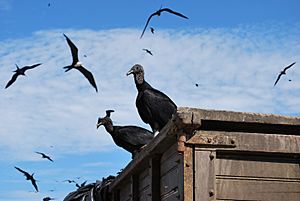
Some cattle ranchers see the black vulture as a threat. This is because they can sometimes prey on newborn cattle. The droppings from black vultures can also harm or kill trees and other plants. These birds are also considered a danger to airplanes, especially when many of them gather near garbage dumps. This happens near the Rio de Janeiro Tom Jobim International Airport, for example.
Black vultures can be kept in zoos or special centers. However, the Migratory Bird Treaty Act of 1918 in the United States only allows this for birds that are injured or cannot go back to the wild. They have special legal protections in the United States, Canada, and Mexico. In the United States, it is against the law to catch, kill, or own black vultures. Breaking this law can lead to a fine of up to US$15,000 and up to six months in prison.
The black vulture is listed as a species of "Least Concern" by the IUCN Red List. This means their populations seem to be stable. They are not considered a threatened species.
The black vulture appears in many Maya hieroglyphics (ancient writings). It is often linked to death or shown as a bird of prey. The vulture's symbol is often shown attacking humans. This species does not have the same religious importance as the king vulture. Some of the writings clearly show the black vulture's open nostril and hooked beak. Others are thought to be this species because they look like vultures but do not have the king vulture's special head bump and are colored black. This vulture has also appeared on two postage stamps: one from Guyana in 1990 and one from Nicaragua in 1994.
Images for kids
-
Adult and juvenile, Hueston Woods State Park, Ohio
-
Soaring over Copacabana, Rio de Janeiro
-
Feeding on a wood stork
See also
 In Spanish: Buitre negro americano para niños
In Spanish: Buitre negro americano para niños



